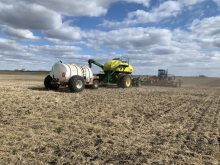First serious challenge to four month rally | Upheaval in Europe shakes bullish market outlook for oilseeds
The numbers were bullish, yet the market did a bearish beat-down on oilseed prices a few days after the May 10 U.S. Department of Agriculture reports.
Market analysts are scratching their heads and trying to figure out if something in the supply and demand fundamentals changed.
Are oilseed prices returning to earth after their recent dramatic increase, dragged down by the enormous weight of the sinking commodity complex?
Is it just a correction after such a strong recent rally?
Does this directional change mean much in the context of the annual summer weather market beginning to take control?
Read Also

One Beer Market Updates Day 3 – Lentils and beef
Day 3 of the One Beer Market Update at Ag in Motion 2025.
“When it’s driven by outside factors, it’s a bit hard to pin down,” Jon Driedger of FarmLink Marketing Solutions said after a two-day canola price slide that cut more than $25 per tonne off July canola futures and about $20 off of November futures.
“The oilseed story really hasn’t changed, but there’s a lot of bigger picture uncertainty out there.”
World markets have been shaken in the past two weeks by the political chaos in Greece, the election of a French socialist president who might not support Germany’s approach to reforming eurozone finances and general world economic slowness.
JP Morgan Chase’s May 11 announce-ment of an unexpected $2 billion loss on a hedge position rattled investors worldwide, who saw echoes of 2008 and signs that the best operators on Wall Street had not necessarily learned how to avoid massive losses.
Commodity markets in general have been falling since the beginning of March and the CRB index, a measure of a basket of commodity prices, is now down 10 percent.
Corn has gradually weakened since the beginning of the year, falling 15 percent for new crop prices. However, its trajectory since March has looked similar to that of the CRB and not weaker.
Soybeans and canola showed the opposite trend until recent days, with new crop canola futures rising 15 percent since the beginning of the year and more for soybeans. They surged higher since March, propelled by strong demand, low stocks and the need to encourage more seeded acreage.
Union Securities broker Ken Ball thinks the dramatic selloff May 11 and May 14 reveals the general commodity slump that is finally hitting oilseeds.
“Crude breaks, gold breaks, now they’re going to have to dump their soybean positions,” Ball said about the investment funds that drove oilseed prices higher but that are now quickly selling to cover losses in other commodities.
“There are a lot of funds taking ugly, ugly hits here. Some of them have collapsed. There has been speculative money flushing out for a while now.”
The USDA supply and demand reports did not directly undermine soybean prices by finding bearish stocks or likely production.
USDA forecasted a 2012-13 U.S. soybean crop of 3.205 billion bushels, the third largest on record. However, because of strong demand it expects stocks by the end of 2012-13 to contract to 145 million bushels, slightly more than a two-week supply and a stocks-to-use ratio “at a historically low 4.4 percent.”
Soybean prices rose immediately after the report.
“Soybean prices to stay the leader of the CBOT complex,” was the title of Barclays’ Commodities Research daily newsletter, mere hours before the two-day price slide began.
Barclays raised its new crop soybean price projection that morning by $1.10 per bushel.
However, by the end of trade May 11, the AgriCharts newsletter noted that “soybeans ended the session sharply lower, not responding to what would be considered positive news to price.”
Ball said a fundamental element of the investment fund selloff might be that the report found no major new bullish information about old crop soybean stocks, pegged at 210 million bushels, so funds might have decided the party was over.
“They said that (stocks number) is not enough to stay in at with $14.50 (soy)beans,” said Ball.
Many analysts don’t accept the USDA’s low acreage number for U.S. soybeans.
The May 10 report used the March Prospective Plantings acreage number and the price rise since then probably encouraged more soybean acres. So traders are adding 60 to 80 million bu. to 2012-13 stocks forecast, putting them in “quasi-comfortable territory,” said Ball.
The coincidence of the soybean and canola price slump with the general world market slump has worried some analysts who fear the oilseeds are succumbing to overwhelming worldwide commodity pressure.
However, there is another happier interpretation for the recent selloff.
Almost no commodity goes straight up continually without a correction, in which overbullishness is taken out of the market by sober second thought.
If the commodity still seems to have the same fundamental strength as it did when it was going up, then it can begin rising again in another leg of a continuing rally.
“If that’s the case, then this isn’t such a bad thing,” said Driedger.


















